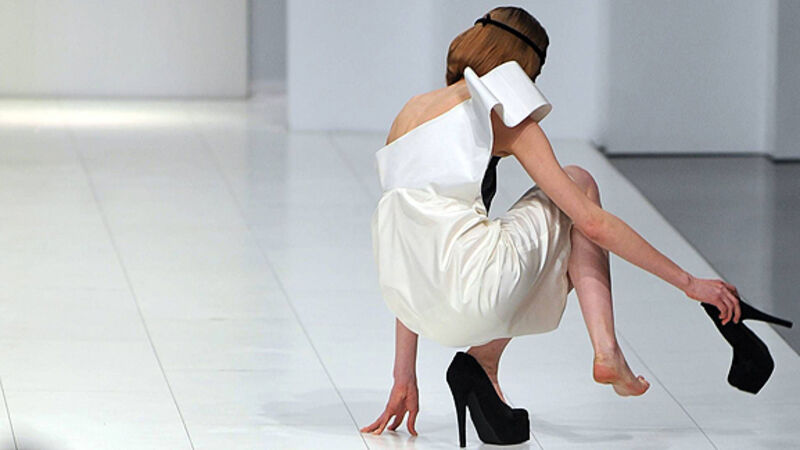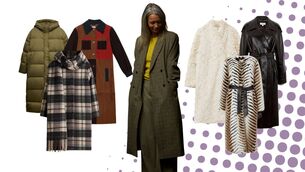The killer heel rises

A FUNNY thing happened in 2008. Heel heights started to grow — higher and higher. Not content with mastering the 4.1-inch Manolo Blahnik Hangisi or the 5.5 inch YSL Tribtoo, die-hard fashionistas took example from celebrities like Posh and Paltrow who began working the red carpet in 6- and 7-inch obelisks.
As retail sales spiked; so did the body count. That same year, the spring/ summer 09 collection previews took multiple victims with models tumbling at Prada and Pucci.
Despite such runway road kill, cobbler Christian Louboutin would announce he was making the first 8-inch heel outside of the fetish world. This was the start of competitive footwear — fashion’s most lethal sport.
Such lofty one-upmanship came with its own set of bragging rights. Much like an Olympic sport, women went to great lengths to prove they could walk effortlessly in the highest of heels with Botox cushion injections, shockwave therapy and high-heel fitness classes cropping up in conurbations.
The ability to transcend pain and fear of a twisted ankle paved the way to golden girl status and with that the bar was raised — again. By 2012 heel heights soon resembled a scoreboard — Natascha Marro (7-inch); Iris Van Herpen (7.4-inch), Jan Taminau (10-inch); Alexander McQueen (12-inch) with a quivering 9- to 18-inches from Japanese designer Noritaka Tatehana.
Backstage rumours of models pulling out of shows on account of gravitydefying shoes became fashion week fodder, laying the gauntlet for two ladies of pedigree to do the honours — Gaga and Guinness. And so the games began.
The beer heiress Daphne worked McQueen’s foot-high Armadillo boots at a NARS launch with a handy cane prop; while her blonde rival danced feverishly in the same cloven clogs to the strains of ‘Bad Romance’.
Round one: Gaga. While Guinness was papped skipping jauntily over cobbles in her heel-less Natascha Marro Mary Janes; the shutterbugs busted Gaga falling from grace in a 9-inch pair of Tatehana contoured wedge boots.
Round two: Guinness. Not one to be outdone, the New York chanteuse chose to step out in a foot-and-a-half high Gaga Pointe ballet shoes. And the winner is …
Therein lies the rub; or the bunion if you will. The potentially injury-inducing architecture of killer heels is that which makes them so appealing; not least the daredevil wearing them. Making the sport look easy is the challenge of any athletic performance. Fearsome footwear is no exception; in fact, it’s the rule.
Just what is it then that is prompting women to risk toe disfigurement, tendon-protraction and social suicide in order to emulate such dizzy heights?
Some experts attribute the rising popularity of high heels to a need for escapism drawing parallels between the current recession and those such as the Great Depression, the 1970s oil crisis and the dot com bubble burst.
Others blame the Hollywood lifestyle, one where a premium is put on glamour and those who perpetuate its crystal-clad veneer.
More commonly, the reason invariably comes back to sex. Christian Louboutin who sells an average of 600,000 pairs of ‘Loubis’ a year in 51 boutiques worldwide, believes carnal desire overrides comfort.
From the revealing toe cleavage to the shape of the heel arch (said to resemble the position of a woman’s foot during orgasm) and its attendant lotus gait, the pleasure is not simply reserved for the fairer sex.
In fact, it is in plumbing both the male and female psyche. Call it porn for women but much like porn, killer heels can be accused of promulgating a fetishistic stereotype of a female ‘ideal’. At some stage, something’s gotta give.
Blisters, corns, lower back pain, toeclawing, numbness and sciatica are just some of the heel-related cases that make up 75% of the podiatry business.
A study carried out by scientists at Griffith University, Queensland, found that regular heel use causes the calf muscle fibres to contract and can reposition the joints and muscles in the feet.
The research, published in the Journal of Applied Psychology, also found the same foot muscles to remain flexed and toes pointed even when heels had been removed.
However damning the evidence, heels it would appear aren’t solely to blame. According to Liz Dunbar of orthotics specialists Tutty’s Shoes in Kildare, nature is as much to blame as nurture.
“Bunions and damaged toes aren’t caused by high heels,” she states.
“It’s your own physical build. If you have a narrow heel base, you can’t really wear high heels regularly. That’s what causes the bunions. You can tell from two or three years of age in a person. That’s why you put an arch support into children’s shoes. When you wear a pair of stilettos, you wind up putting pressure on the toes as the heel is too narrow to grip the back of the shoe.”
Even for those who haven’t won the genetic heel lottery, the leg-lengthening appeal of the super heel doesn’t look set to wane. So what are the limit-pushing styles that have women literally weak at the knees?
Luxury etailers Net-a-Porter.com host a selection of sexy stilts; the highest being a pair of 7-inch cut-out leather sandals by Versace (€890) with a stabilising 3-inch platform.
As for price, Christian Louboutin’s 6.5-inch Daffodile 160 crystal-embellished suede pumps, clock in at a nosebleed-inducing €4,195.
Other styles popular with shoe fans include Charlotte Olympia’s ’40sinspired Dolly pumps bearing a signature ‘floating island’ platform (€695), and another Gaga favourite, Giuseppe Zanotti’s 6.5-inch Swarovski crystal-embellished contoured wedge pumps (€1,395).
Harvey Nichols, who’ve had success with YSL’s Tribute (5.5-inch) and Tribtoo (5-inch) pumps, now do well with pointy stilettos like the Piou Piou (3.5-inch) from Louboutin and Jimmy Choo’s Abel (4-inch); not to mention Jeffrey Campbell whose 5-inch Lita platform boots (€145) have become a fashion blogger favourite.
Solestruck.com, stockist of the sell-out Iris Van Herpen x United Nude Iris boot (6-5-inch), harbours a fatalistic review from an avid fan: “Who knows if I’ll ever be able to make it out of the house wearing them?’ Along with the $995.95 price tag, one supposes this is part of the price paid for ‘fashion’.”
And so it goes. As long as competitive footwear exists, women will continue to challenge the Theory of Gravitation, despite the odds.
What comes up may indeed come down but only those that manage the feat can boast of its delicious thrill.










